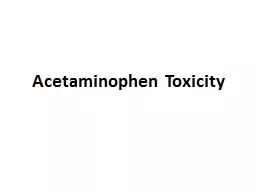

Principle pf the disease Clinical features Diagnosis Management Overview Acetaminophen is one of the most commonly used antipyretic and analgesic agents throughout the world Acetaminophen is found as an isolated product or in combination medications for the treatment of cold symptoms pain ID: 907955
Download Presentation The PPT/PDF document "Acetaminophen Toxicity Overview" is the property of its rightful owner. Permission is granted to download and print the materials on this web site for personal, non-commercial use only, and to display it on your personal computer provided you do not modify the materials and that you retain all copyright notices contained in the materials. By downloading content from our website, you accept the terms of this agreement.
Slide1
Acetaminophen Toxicity
Slide2Overview
Principle pf the disease
Clinical features
Diagnosis
Management
Slide3Overview
Acetaminophen is one of the most commonly used antipyretic and analgesic agents throughout the world.
Acetaminophen is found as an isolated product or in combination medications for the treatment of cold symptoms, pain, and headache.
Slide4It’s a very common drug all over the world in both oral and IV route.
toxicity is a concern in all intentional ingestions as well as with repeated
supratherapeutic
dosing and drug abuse.
Slide5Principles of the disease
Acetaminophen is absorbed
rapidly
, with peak plasma concentrations generally occurring
within 1 hour
and complete absorption
within 4 hours.
acetaminophen inhibits prostaglandin E2 (PGE2) synthesis, leading to
antipyresis
and analgesia
Slide6Slide7At therapeutic doses, 90 percent of acetaminophen is metabolized in the liver to
sulfate
and
glucuronide
conjugates then excreted in the urine.
Slide8One-half of the remaining acetaminophen is excreted unchanged in the urine and one-half is metabolized via the hepatic cytochrome P450 to N-acetyl-p-
benzoquinoneimine
(
NAPQI
), which is
hepatotoxic
.
Slide9With normal doses ,NAPQI is rapidly conjugated to hepatic glutathione, forming nontoxic cysteine and
mercaptate
compounds that are
excreted i
n the urine.
Slide10With toxic doses the sulfate and
glucuronide
pathways become
saturated
, resulting in an increased fraction of acetaminophen being metabolized by cytochrome P450 enzymes.
Once glutathione stores are depleted, NAPQI begins to
accumulate
and
hepatic injury
ensues.
Slide11Clinical features
Early
1
st
8 hours.
Nonspecific
Mild symptoms such as nausea ,vomiting or anorexia.
Slide12Liver injury
Between 8 and 36 hours.
RUQ pain
RUQ tenderness
Jaundice
Vomiting
High LFTs.
Slide13Liver failure
Metabolic acidosis
Coagulopathy
Hepatic encephalopathy
Slide14Death
may occur from hemorrhage, adult respiratory distress syndrome, sepsis,
multiorgan
failure, or cerebral edema
.
Slide15Slide16Diagnosis
Acetaminophen toxicity should be consider in any patient with drugs overdose
Slide17History
The amount
150mg/kg
The time since ingestions
4 hours
8 hours
Slide18Laboratory
CBC
U&Es
LFTs
VBG
Serum level
PT.PTT,INR
Slide19LFTs
AST is the
first
enzyme to raise.
Alanine transaminase (ALT), prothrombin time, and bilirubin typically begin to rise and peak shortly after AST values
With severe toxicity, AST, ALT, and the prothrombin time may all be elevated within 24 hours
Slide20Serum level
serum acetaminophen concentration 4 hours after ingestion or as soon as possible after 4 hours.
Slide21The serum acetaminophen concentration and the time of ingestion determine the need for antidotal therapy
.
Slide22Slide23Measurement of serum acetaminophen concentration before 4 hours is typically not necessary.
Slide24there is little need to treat patients before 6 to 8 hours after ingestion
patients treated with
NAC (N-
Acetylcysteine
)
up to 6 hours after ingestion, even after very large doses,
have no increased risk of hepatotoxicity
regardless of their serum acetaminophen concentration.
Slide25the risk of hepatotoxicity does not significantly increase unless NAC is delayed for 8 hours or longer after ingestion
Slide26Management
The mainstays of management are to provide supportive
care and
to initiate NAC therapy when it is indicated
Slide27Gastric decontamination
Usually not needed
Slide28N-
Acetylcysteine
When it is indicated, NAC should be administered as early as possible
.
Delay of NAC administration for more than 8 hours
after ingestion
increases the risk of hepatotoxicity
Slide29The main role of early NAC administration is to
prevent hepatotoxicity by detoxifying NAPQI and
decreasing NAPQI production
Slide30NAC can be administered by the oral (PO) or IV route,
with advantages
and disadvantages for
each.
All formulations of
NAC(PO
and IV) are
effective
when they are started within
8
hours
of ingestion.
Slide31Slide32Slide33Supportive care
Supportive care includes management of
coingestions
and the nausea and vomiting, hepatic injury, and renal dysfunction related to acetaminophen poisoning.
Slide34Q?